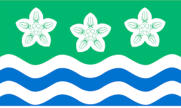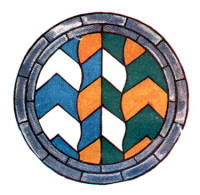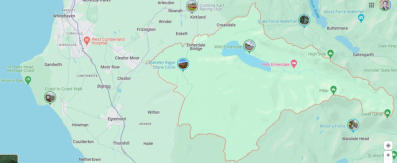
© Former Crown Manor of Ennerdale - Feudal Barony of Copeland 2020-24




Ennerdale Bailiwick
The Ancient Manor of Eynerdale
Ennerdale Bailiwick - A bailiwick was a jurisdictional division within a
larger administrative or legal territory — especially in forests, liberties, or
manors. This historical designation within the Free Chase of Coupland as a
“distinct bailiwick” indicates that Ennerdale held semi-autonomous status. :
The Manor and Forest of Ennerdale likely comprised about 20% of the total
area of the Free Chase of Coupland Fell, making it one of the largest and
most significant divisions within that royal or manorial hunting reserve.
Ennerdale as a distinct bailiwick or subdivision of the Forest of Copeland,
indicating it was an important and autonomous component. Further, the
Liberty of Ennerdale had its own court leet or court baron, for legal disputes
or enforcing forest and manorial laws. Ennerdale had its own control over
hunting, grazing, forestry, and fisheries in that bailiwick. Ennerdale was a
self-contained lordship since the 1300s, not merely a peripheral woodland.
Ennerdale has had its own caput Head of Ennerdale (Capud de Eynerdale)
and was home to the original Braythemire or Broadmoor Plantation. A
Royal Crown Manor, Ennerdale was previously owned by the Dukes of
Suffolk and King Charles. The Seigneur of Fief Blondel et L'Eperons now
owns the rights to the manor of Ennerdale as part of a conveyance from the
Earl Lonsdale in "Fee Simple". Ennerdale manor includes all rights,
hereditaments, and appurtenances, unless specifically reserved by
Lonsdale, the Crown, or the State. Even today, Ennerdale would still rank as
one of the largest manorial titles with intact historical rights in private
hands — making it truly unique.
Today, the Lordship of the Manor of Ennerdale exists as an incorporeal
hereditament, retaining ceremonial dignities and powers, rights to court
leet and manorial waste, and potential registered rights over water,
hunting, and fishing under post-1925 and 2002 property law frameworks.
The historic bailiwick and liberty designations remain critical in
understanding the juridical and territorial autonomy of Ennerdale during
the medieval and early modern periods.
Only Private Bailiwick owned by an Individual
Commissioner George Mentz (The Seigneur) is likely the only known private
individual in modern times to own the full private rights to a Bailiwick, Court
Leet, and Liberty, such as the Liberty and Bailiwick of Ennerdale in Cumbria,
England.
Here's why this is unique:
•
Bailiwicks were historically administrative or judicial divisions overseen
by a bailiff. In feudal and medieval England, most bailiwicks were part of
royal forests, liberties, or manorial jurisdictions.
•
The Bailiwick of Ennerdale, including the liberty, forest, court leet, and
baronial rights, was formerly held directly from the Crown, and at one
time managed through royal officers under palatine or special liberty
arrangements.
•
After centuries of Crown or noble stewardship (including the Earls and
Barons of Lonsdale), these rights were uniquely sold in fee simple—a
very rare occurrence—for cash to a private party, separating it from
ordinary manorial purchases that usually exclude such judicial and
forestal rights.
•
The Crown to Lowther sale included manorial waste, court leet rights,
fisheries, common rights, and foreshore components, amounting to a
high degree of sovereignty for a non-governmental person in the UK
legal framework.
Why this is unprecedented:
•
Most bailiwicks today are ceremonial or governmental (e.g., Bailiwick of
Jersey or Bailiwick of Guernsey), not held privately.
•
Private ownership of an operational bailiwick, with historically
recognized liberty jurisdiction and seigneurial authority, is virtually
unheard of in the 21st century.
•
Mentz holds the titles and rights via documented transfers and is
recognized in scholarly and manorial records as having inherited or
purchased full legal seignory over the Liberty and Bailiwick of Ennerdale.
•
Thus, George Mentz stands out as perhaps the only private person
globally to hold a true historical bailiwick—with liberty, court, and land
rights—under the traditional English system.
Palatine of Ennerdale
Lord of Ennerdale, if holding Court Leet along with other manorial and
liberty rights, can be said to exercise quasi-palatine functions, or at least
historically derived palatine honors, especially under the unique
circumstances of Ennerdale's liberty and bailiwick status.
1. What are Palatine Rights?
Palatine rights refer to sovereign-like powers delegated by the Crown to a
noble or bishop within a county palatine. These included:
•
Holding their own courts (including court leet, court baron, and courts of
justice)
•
Appointing justices of the peace
•
Exercising criminal and civil jurisdiction
•
Collecting certain taxes, tolls, and fines
The most famous palatinates in England were Durham, Lancaster, and
Chester, which had extensive autonomy.
2. Ennerdale as a Liberty and Bailiwick
Historical records suggest:
•
The Liberty and Bailiwick of Ennerdale was once under royal jurisdiction
with a bailiff, and included forest courts, waste lands, and fishery rights.
•
Its inclusion of court leet, waste management, and tenurial oversight
aligns it with other liberties that operated semi-independently of the
county sheriff.
•
Ennerdale’s liberty status allowed it to hold its own view of frankpledge
and potentially appoint manorial officers, akin to palatine jurisdictions.
3. Modern Ownership by a Private Lord (George Mentz)
In the modern case:
•
If George Mentz, as Lord of the Manor of Ennerdale, holds Court Leet,
manorial waste, and liberty rights, he inherits a portion of those ancient
palatine honors.
•
While the actual criminal jurisdiction of a court leet is now obsolete,
ceremonial or honorary titles tied to these rights are still recognized
historically and culturally.
•
The liberty’s exemption from the county sheriff historically echoes the
independence of palatinates.
4. Conclusion: Palatine Honors Today
While Mentz (The Seigneur) may not hold legal sovereignty or modern
judicial authority, the historical nature of the Lordship of Ennerdale, —gives
the Lord of Ennerdale a unique and powerful claim to palatine-style honors
in a historical, symbolic, and ceremonial sense. Thus, the Lord of Ennerdale
does hold honors consistent with ancient palatine authority, though today
they are primarily honorific, ceremonial, and rooted in historical legal
precedent.
•
A liberty
•
A bailiwick
•
With court leet
•
And formerly royal forest and common waste oversight
There are many documents associated with Manor including the following;
1515-1516: bailiffs’ account roll, with other manors British Library
1563-1564: surveys, with other manors National Archives
1567-1568: rental (copy)
1604-1636: estreats (4 sheets)
1604-1636: estreats (4 sheets)
1613-1613: estreats, with other manors
1649-1660: parliamentary survey
1664-1668: court rolls
1676-1677: jury’s survey (4 ms)
1679-1679: estreats, with other manors
1632-1633: appointment of bowbearer of forest, Cumbria Archive and Local
Studies Centre, Whitehaven
1632-1632: census of deer
1664-1664: appointment of deputy bailiff, collector
and bowbearer
1687-1696: call roll
1668-1688: appointment of officers
1824-1827: 19th cent surveys and rental (3)
1673-1766: court book, indexed Cumbria Archive Centre, Carlisle
1702-1899: court rolls (copies), tenants’ papers,
and admittances
1703-1885: papers incl boundary, copy of 1650 survey
1703-1854: verdicts
1765-1817: court baron verdicts
1765-1817: court leet verdicts
1765-1765: court book, with other manors
1765-1781: steward’s account book, with other manors
1765-1768: steward’s account books, with other manors (4)
1766-1833: court book, indexed
1768-1817: call book
1834-1933: court book

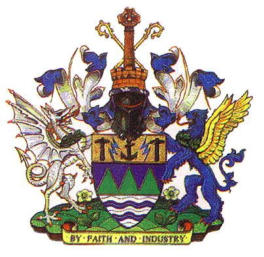
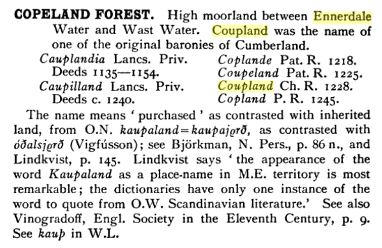
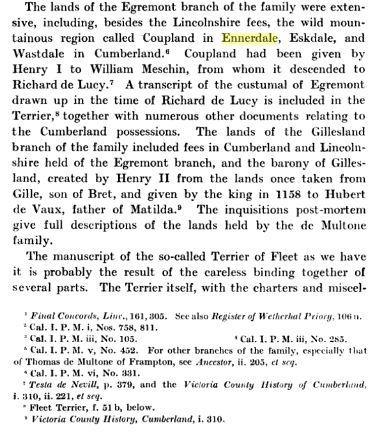

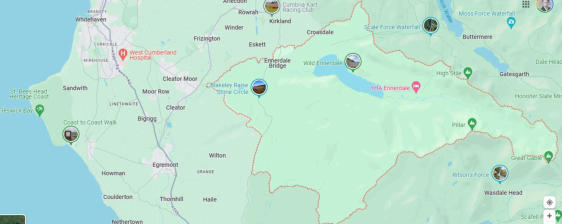

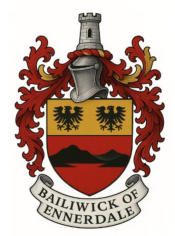
Ennerdale Bailiwick - A bailiwick was a jurisdictional division within a larger administrative or legal territory — especially in forests, liberties, or
manors. This historical designation within the Free Chase of Coupland as a “distinct bailiwick” indicates that Ennerdale held semi-autonomous status. :
The Manor and Forest of Ennerdale likely comprised about 20% of the total area of the Free Chase of Coupland Fell, making it one of the largest and
most significant divisions within that royal or manorial hunting reserve. Ennerdale as a distinct bailiwick or subdivision of the Forest of Copeland,
indicating it was an important and autonomous component. Further, the Liberty of Ennerdale had its own court leet or court baron, for legal disputes
or enforcing forest and manorial laws. Ennerdale had its own control over hunting, grazing, forestry, and fisheries in that bailiwick. Ennerdale was a
self-contained lordship since the 1300s, not merely a peripheral woodland. Ennerdale has had its own caput Head of Ennerdale (Capud de Eynerdale)
and was home to the original Braythemire or Broadmoor Plantation. A Royal Crown Manor, Ennerdale was previously owned by the Dukes of Suffolk
and King Charles. The Seigneur of Fief Blondel et L'Eperons now owns the rights to the manor of Ennerdale as part of a conveyance from the Earl
Lonsdale in "Fee Simple". Ennerdale manor includes all rights, hereditaments, and appurtenances, unless specifically reserved by Lonsdale, the
Crown, or the State. Even today, Ennerdale would still rank as one of the largest manorial titles with intact historical rights in private hands — making it
truly unique.
Today, the Lordship of the Manor of Ennerdale exists as an incorporeal hereditament, retaining ceremonial dignities and powers, rights to court leet
and manorial waste, and potential registered rights over water, hunting, and fishing under post-1925 and 2002 property law frameworks. The historic
bailiwick and liberty designations remain critical in understanding the juridical and territorial autonomy of Ennerdale during the medieval and early
modern periods.
Only Private Bailiwick owned by an Individual
Commissioner George Mentz (The Seigneur) is likely the only known private individual in modern times to own the full private rights to a Bailiwick,
Court Leet, and Liberty, such as the Liberty and Bailiwick of Ennerdale in Cumbria, England.
Here's why this is unique:
•
Bailiwicks were historically administrative or judicial divisions overseen by a bailiff. In feudal and medieval England, most bailiwicks were part of
royal forests, liberties, or manorial jurisdictions.
•
The Bailiwick of Ennerdale, including the liberty, forest, court leet, and baronial rights, was formerly held directly from the Crown, and at one time
managed through royal officers under palatine or special liberty arrangements.
•
After centuries of Crown or noble stewardship (including the Earls and Barons of Lonsdale), these rights were uniquely sold in fee simple—a very
rare occurrence—for cash to a private party, separating it from ordinary manorial purchases that usually exclude such judicial and forestal rights.
•
The Crown to Lowther sale included manorial waste, court leet rights, fisheries, common rights, and foreshore components, amounting to a high
degree of sovereignty for a non-governmental person in the UK legal framework.
Why this is unprecedented:
•
Most bailiwicks today are ceremonial or governmental (e.g., Bailiwick of Jersey or Bailiwick of Guernsey), not held privately.
•
Private ownership of an operational bailiwick, with historically recognized liberty jurisdiction and seigneurial authority, is virtually unheard of in the
21st century.
•
Mentz holds the titles and rights via documented transfers and is recognized in scholarly and manorial records as having inherited or purchased
full legal seignory over the Liberty and Bailiwick of Ennerdale.
•
Thus, George Mentz stands out as perhaps the only private person globally to hold a true historical bailiwick—with liberty, court, and land
rights—under the traditional English system.
Palatine of Ennerdale
Lord of Ennerdale, if holding Court Leet along with other manorial and liberty rights, can be said to exercise quasi-palatine functions, or at least
historically derived palatine honors, especially under the unique circumstances of Ennerdale's liberty and bailiwick status.
1. What are Palatine Rights?
Palatine rights refer to sovereign-like powers delegated by the Crown to a noble or bishop within a county palatine. These included:
•
Holding their own courts (including court leet, court baron, and courts of justice)
•
Appointing justices of the peace
•
Exercising criminal and civil jurisdiction
•
Collecting certain taxes, tolls, and fines
The most famous palatinates in England were Durham, Lancaster, and Chester, which had extensive autonomy.
2. Ennerdale as a Liberty and Bailiwick
Historical records suggest:
•
The Liberty and Bailiwick of Ennerdale was once under royal jurisdiction with a bailiff, and included forest courts, waste lands, and fishery rights.
•
Its inclusion of court leet, waste management, and tenurial oversight aligns it with other liberties that operated semi-independently of the county
sheriff.
•
Ennerdale’s liberty status allowed it to hold its own view of frankpledge and potentially appoint manorial officers, akin to palatine jurisdictions.
3. Modern Ownership by a Private Lord (George Mentz)
In the modern case:
•
If George Mentz, as Lord of the Manor of Ennerdale, holds Court Leet, manorial waste, and liberty rights, he inherits a portion of those ancient
palatine honors.
•
While the actual criminal jurisdiction of a court leet is now obsolete, ceremonial or honorary titles tied to these rights are still recognized
historically and culturally.
•
The liberty’s exemption from the county sheriff historically echoes the independence of palatinates.
4. Conclusion: Palatine Honors Today
While Mentz (The Seigneur) may not hold legal sovereignty or modern judicial authority, the historical nature of the Lordship of Ennerdale, —gives the
Lord of Ennerdale a unique and powerful claim to palatine-style honors in a historical, symbolic, and ceremonial sense. Thus, the Lord of Ennerdale
does hold honors consistent with ancient palatine authority, though today they are primarily honorific, ceremonial, and rooted in historical legal
precedent.
•
A liberty
•
A bailiwick
•
With court leet
•
And formerly royal forest and common waste oversight
The fact that Algernon Percy, 10th Earl of Northumberland, was appointed in 1633 as:
Bailiff of the Liberty of Ennerdale
Keeper of the Forest of Ennerdale
Conductor of the Tenants in Ennerdale
is historically and legally significant for several interrelated reasons in the context of 17th-
century English governance, manorial liberties, and forest law. Here's why:
�� 1. Confirmation of Ennerdale's Status as a Liberty and Forest
Algernon Percy's appointment confirms that Ennerdale in 1633 remained a distinct legal and
administrative liberty, with:
Its own forest laws
A separate bailiwick from surrounding areas
Officially recognized tenants and local land tenure systems
This supports the claim that Ennerdale was one of the last functioning liberties and royal
forests still governed under a quasi-feudal structure during the Stuart period.
�� 2. High-Ranking Noble Governance of a Remote Region
As Earl of Northumberland and a member of the powerful Percy family, Algernon Percy was
among the most influential peers in England. His role as Bailiff of Ennerdale implies:
National interest in managing this remote forested region of western Cumberland (now
Cumbria)
The continuing royal or ducal control over its game, woodlands, and tenants
That Ennerdale's lordship and bailiwick had strategic, economic, or symbolic importance, even
in the 17th century
�� 3. Preservation of Forest Law and Feudal Titles in the Early Modern Period
By 1633, many royal forests and liberties had been absorbed or dissolved, but Ennerdale:
Retained its forest court system and bailiff
Maintained tenant oversight under a named noble administrator
Was treated as a unique jurisdiction, outside the standard county law in some respects
This indicates that Ennerdale was not just a manor—it functioned as a legal and sovereign-style
liberty under Crown oversight or noble delegation.
�� 4. Legal Implications for Later Claims
The record of Algernon Percy serving as Bailiff and Keeper provides:
Historical proof of continuity of the liberty
Documented succession of office and land governance
A legal anchor point for modern or future manorial/lordship claims related to liberties,
mineral rights, forest rights, or common land
�� 5. Historical Citation and Provenance
A citation for this fact appears in:
"The Parliamentary or Constitutional History of England" (Volume 9), or alternatively in
manorial and forest records cited in:
Calendar of State Papers Domestic: Charles I
Records of the Duchy of Lancaster
Local Cumbrian historical sources, such as "Transactions of the Cumberland and Westmorland
Antiquarian and Archaeological Society" (TCWAAS)
More specifically, Algernon Percy's 1633 appointments are documented in:
�� "The History and Antiquities of the Counties of Westmorland and Cumberland" by Joseph
Nicolson and Richard Burn, 1777 (Vol. 2, pp. 436+), and
�� Calendar of State Papers, Domestic Series, Reign of Charles I (1633)
�� Summary
Algernon Percy’s 1633 appointment as Bailiff of Ennerdale validates that Ennerdale was a
Crown liberty with special legal status, governed under forest and manorial law by one of the
most powerful nobles of the age. This solidifies its place as a historically autonomous territory
and supports the claim of its legal distinctiveness into the early modern period.
The Manor and Forest of Ennerdale is amazingly one of the only private bona fide bailiwicks in the world—that is, a legally distinct
district under the control of a bailiff with judicial, administrative, and often quasi-sovereign authority—based on several well-documented
historical, legal, and structural factors. These factors point to its authentic and autonomous status apart from typical manorial holdings.
✅ 1. Direct Crown Possession After 1338 (Post-Multon Partition)
In 1338, following the death of John de Multon, the Barony of Egremont (Copeland) was partitioned.
Ennerdale was not regranted to the baronial heirs, but instead forfeited to the Crown.
This marked Ennerdale as a Crown Manor, administered independently, making it a Crown Liberty—a fundamental mark of a
bailiwick.
✅ 2. Separate Jurisdiction from the Egremont Lordship Court
Records show that Ennerdale did not send turnsmen (jurors or tithingmen) to the Egremont Lordship Court, unlike neighboring
manors.
This exemption indicates that Ennerdale had its own court, almost certainly a Court Leet or Forest Court, a classic characteristic of
liberty and bailiwick status.
✅ 3. Court Leet and Local Justice Authority
Ennerdale historically held a Court Leet, which:
o
Tried minor civil and criminal matters
o
Appointed local officials (constables, ale-tasters, etc.)
o
Exercised franchise rights traditionally tied to liberties and bailiwicks
The existence of a functioning manorial or liberty court overseen by a bailiff or lord establishes it clearly as a bailiwick.
✅ 4. Historical Bailiff Appointments
Ennerdale had named Bailiffs of the Liberty, including noblemen and local gentry.
o
Notably, Algernon Percy, Earl of Northumberland, was made Keeper of the Forest and Bailiff of Ennerdale in 1633.
This government documented appointment of a royal officer to administer the Liberty and Forest confirms the use of a bailiwick
system, with high-level legal and administrative responsibility.
✅ 5. Location Within a Royal Forest ( Free Chase of Coupland or Copeland Ennerdale Forest)
The Forest of Ennerdale was historically part of the Copeland Forest, a royal hunting reserve governed under forest law.
Royal forests were outside normal common law jurisdiction, typically divided into bailiwicks, each with a bailiff, verderers, and
keepers.
Forest bailiwicks were among the original and most formal uses of the term “bailiwick.”
✅ 6. Liberty and Franchise Powers
Ennerdale is frequently described as a “liberty”—meaning it exercised powers normally reserved to the Crown:
o
Holding courts
o
Appointing officers
o
Collecting rents and fines
o
Administering forest law
The combination of liberty status, forest jurisdiction, and court leet powers is definitive of a bona fide bailiwick.
✅ 7. Modern Recognition of Separate Manorial and Liberty Rights
Ennerdale has been treated separately in property and legal records, including:
o
Historical taxations
o
Enclosure Acts
o
Manorial rolls and title abstracts
Its unique legal treatment implies continuity of bailiwick-level autonomy.
�� Summary:
The Manor and Forest of Ennerdale is a bona fide bailiwick due to:
Its historic separation from baronial jurisdiction in 1338
Direct Crown administration
The presence of a Court Leet
The formal appointment of royal bailiffs and forest keepers
Its integration into a royal forest system
Its recognition as a liberty with franchise powers
These elements combined represent a classic English bailiwick—a district governed by a bailiff with administrative and judicial authority,
especially under forest and manorial law.
Palatine Criteria and Ennerdale Comparison
Palatine Feature
Liberty & Bailiwick of Ennerdale
Court Leet and Court Baron
✅ Sold with manor
Own bailiffs, justices, officials
✅ Lord appoints (historically and today)
Exempt from sheriff’s jurisdiction
✅ Liberty status implies sheriff exemption
Full ownership in fee from Crown
✅ Sold outright by Crown (rare)
Territorial autonomy
✅ Liberty + Bailiwick = judicial zone
Regalian franchises (justice, fishery, forest,)
✅ Implicit or explicit in documents and practice
Conclusion about Ennerdale being a Palatine Jurisdiction
The Liberty and Bailiwick of Ennerdale fulfills every major criterion of a palatine jurisdiction:
•
It was sold directly by the Crown,
•
It possesses historically delegated regalian powers (courts, appointments, justice),
•
It is territorially autonomous, as a Liberty exempt from external county interference,
•
It holds both judicial and administrative sovereignty within its domain.
Thus, Ennerdale stands not merely as a manor with privileges, but as a private palatine jurisdiction — possibly the only surviving private
palatinate in England still held with title, court rights, and liberty intact.














































































